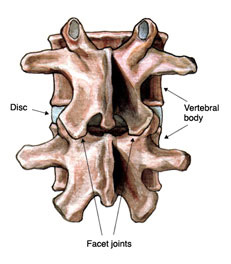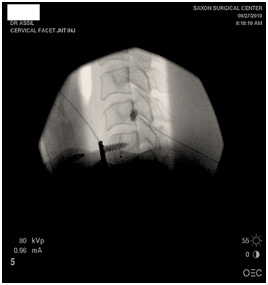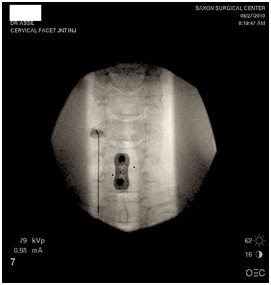Facet Joint or Medial Branch Nerve Block
Diagnostic and Therapeutic Benefits for Neck and Back Pain
Inflammation between the spine's facet joints, often due to trauma or arthritis, can cause neck and low back pain. Facet joint arthropathy can also be attributed to pivotal forces at adjacent levels above and below a spine fusion. Facet joint and medial branch nerve blocks involve injecting a local anesthetic and steroid medication into one or more joint structures to determine if a specific joint is the potential source of neck or low back pain. Many doctors use these procedures to diagnose the potential source of neck or low back pain.
In the cervical spine, the neck's upper facet joints can cause posterior (behind) headaches. The neck's lower facet joints can cause neck pain and referred pain to the back of the shoulder (scapular area).
In the lumbar spine, the facet joints can cause low back, hip, and buttock pain.
While these provide valuable diagnostic information, inflammation and pain may be reduced.
- A facet joint block is an injection of local anesthetic and steroid medication into the facet joint.
- A medial branch block uses similar medications injected outside and next to the joint space near the small nerve that feeds a specific joint.
- Both injection procedures are performed using fluoroscopic guidance (real time x-ray).
- Great precision in technique is required for such diagnostic injections.
If pain is relieved, it could mean that the joint is a potential pain generator.
Video: Facet Joint Syndrome
Click below to view a video from our library about Facet Joint Syndrome.
Basic Facet Joint Anatomy
Each vertebra in the cervical (neck), thoracic (chest), and lumbar (low back) has two sets of facet joints at the back of the spine. One pair faces upward and one downward with a joint on the left and right sides of the vertebra. Facet joints are hinge-like and link vertebrae together.

Each facet joint is innervated by a medial branch nerve. The medial branch nerves control sensation to the facet joint. When there is inflammation within a facet joint, pain activates the medial branch nerve. These nerves do not control sensations or muscles in your arms or legs.
Video: Facet Joint Injections
Click below to view a video from our library about Facet Joint Injections.
Video: Medial Branch Block
Click below to view a video from our library about Medial Branch Block.
Patient Procedure Preparation
In advance of your procedure appointment, our medical team provides you with instructions specific to you and medications you regularly take.
If you take blood-thinning medication, such as Coumadin, Plavix, Prodaxa, aspirin, etcetera, please notify our medical team. Certain drugs must be stopped several days before your procedure.
Possible Risks and Complications
A facet joint or medial branch nerve block, like other medical procedures, may present risks. Complications include risk of infection, low blood pressure, headache, injury to nerve tissue, and allergic reaction to medication.
What to Expect: The Procedure and After
Upon arrival at the treatment facility, our nurses will meet you in the preoperative area. If necessary, medications to relax you are given intravenously (IV). Depending on the facility where your procedure will be performed, Dr. Assil allows one family member to be present in the operating room.
In the operating room, you are comfortably positioned facing down. A cushion is placed under your chest (for neck injections) or abdomen (for low back injections). Next, the skin area is cleansed with a sterile soap. A local anesthetic is injected and given time to take effect.
Using fluoroscopic guidance (real time x-ray), the doctor proceeds with the procedure and places the needle tip at the target area. The doctor confirms the needle tip is properly positioned visually and fluoroscopically. He then injects a small amount of contrast (dye) to ensure correct spread. Next, a low volume anesthetic / steroid solution is injected into the specific location. Rarely, pain is increased during the injection. However, our medical team is dedicated to making you as comfortable as possible. At the end, a small Band-Aid covers the injection site.


Sample of Dr. Assil?s fluoroscopy photos during a cervical facet injection
Depending on the number of spinal levels injected (usually 2); the procedure takes 15 to 20 minutes. Afterward, in the recovery area, you are closely monitored.
Before you are released home, our medical team provides you with written home care instructions. Since facet joint injections serve a diagnostic purpose, after your procedure, please keep a record of where your pain is in relationship to the injection site. In general, you can expect one of the following:
- Great pain relief
- No pain relief
- Pain is relieved, returns for a short time period, and then improves again
Conclusion
A member of our medical team will telephone you 24 to 48 hours after your facet joint or medial branch nerve block to follow-up. We recommend that you keep a daily journal of your pain level and other symptoms following your procedure. Please be specific and keep in mind where pain and symptoms are in relationship to the injection site. The pain diary will help you provide your doctor with detailed information about your treatment progress when you come back for your follow-up office visit.
Download Facet Injections Post-Procedure Care Form
You will be provided with specific discharge instructions following your procedure customized to your condition. The attached instructions are provided only as an indication for pre-planning purposes and do not replace or supercede the specific discharge instructions, which will be provided to you by the Recovery Nurse.
Our multidisciplinary pain practice is
interventional and comprehensive.

Some Conditions We Treat
- Herniated Disc
- Peripheral Neuralgia
- Post Laminectomy Syndrome
- Spinal Stenosis
- Spinal Spondylolisthesis

